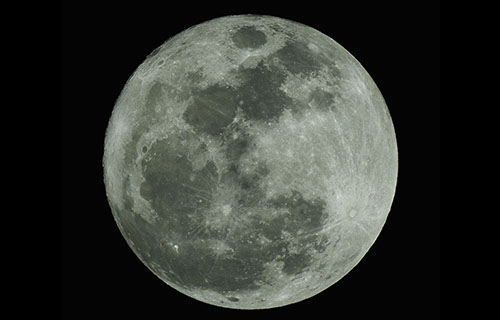Though data from orbiters have suggested presence of ນ້ໍາ ice, the exploration of lunar craters in the polar regions of moon has not been possible due to the absence of suitable technology to power lunar rovers in the perpetually dark, super cold areas having a temperature of –240°C. The project PHILIP (‘Powering rovers by High Intensity Laser Induction on ດາວເຄາະ’) commissioned by European Space Agency is ready to develop prototypes that would provide laser power to these rovers in an effort to explore evidence of existence of ນ້ໍາ in these craters.
Moon ບໍ່ rotate ໃນແກນຂອງມັນຍ້ອນວ່າມັນ ໝູນ ອ້ອມໂລກ, ສະນັ້ນອີກດ້ານ ໜຶ່ງ ຂອງດວງຈັນແມ່ນບໍ່ເຄີຍເຫັນໄດ້ຈາກໂລກ, ແຕ່ທັງສອງດ້ານໄດ້ຮັບແສງແດດສອງອາທິດຕາມມາເປັນເວລາສອງອາທິດ.
However, there are sunken areas in craters situated in the polar regions of moon that never receive sun-light because low angle of sunlight that leave the deep interiors of the craters in shadow forever. This perpetual darkness in the polar craters make them super cold in the range of –240°C corresponding roughly to about 30 Kelvin i.e. 30 degrees above absolute zero. The data received from the lunar orbiters of ESA, ISRO ແລະ ອົງການ NASA have shown that these permanently shadowed areas are rich in hydrogen, suggestive of presence of ນ້ໍາ (ice) in these craters. This information is of interest for science as well as a local source of ‘ນ້ໍາ and oxygen’ for future moon human habitation. Therefore, there is a need of a rover that could go down to such craters, drill and bring sample for testing to confirm presence of ice there. Given lunar rovers are usually solar powered, this has not been achieved so far because it has not been possible to ensure power supply to rovers while it explores some of these dark craters.
ການພິຈາລະນາອັນໜຶ່ງແມ່ນຈະມີຍານສຳຫຼວດນິວເຄລຍ ແຕ່ອັນນີ້ຖືກພົບເຫັນວ່າບໍ່ເໝາະສົມສຳລັບການສຳຫຼວດນ້ຳກ້ອນ.
ໂຄງການດັ່ງກ່າວໄດ້ຮັບຮູ້ຈາກບົດລາຍງານຂອງການນໍາໃຊ້ laser ເພື່ອພະລັງງານ drones ເພື່ອຮັກສາໃຫ້ເຂົາເຈົ້າສູງເປັນເວລາດົນນານ, ໂຄງການ. ຟີລິບ (‘Powering rovers by High Intensity Laser Induction on ດາວເຄາະ’) was commissioned by European Space Agency to design a complete ພະລັງງານເລເຊີ ພາລະກິດຂຸດຄົ້ນ.
The PHILIP project is completed now and the ESA is one step closer to powering lunar rovers with lasers to explore the super cold dark craters ດວງຈັນ ໃກ້ກັບເສົາ.
ESA would now begin to develop prototypes for exploring the dark craters that would provide evidence for confirmation of the presence of ນ້ໍາ (ice) leading to realisation of human dream to inhabit this satellite.
***
ແຫລ່ງທີ່ມາ:
ອົງການອະວະກາດເອີຣົບ 2020. ການເປີດໃຊ້ງານ & ສະໜັບສະໜູນ / ວິສະວະກຳອະວະກາດ & ເທັກໂນໂລຍີ. ຍານ Rover ທີ່ໃຊ້ພະລັງງານເລເຊີເພື່ອສຳຫຼວດເງົາມືດຂອງດວງຈັນ. ປະກາດໃນວັນທີ 14 ພຶດສະພາ 2020. ມີຈຳໜ່າຍແລ້ວທີ່ http://www.esa.int/Enabling_Support/Space_Engineering_Technology/Laser-powered_rover_to_explore_Moon_s_dark_shadows ເຂົ້າໃຊ້ໃນວັນທີ 15 ພຶດສະພາ 2020.
***






































